Teach Your Pup to Walk Nicely on Leash
By Michele Welton, Dog Trainer, Breed Selection Consultant, Author of 15 Dog Books
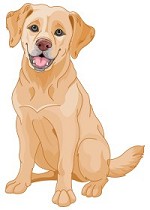 This article is for dogs who pull on the leash.
This article is for dogs who pull on the leash.
If your dog has never had a leash on, or if he refuses to walk at all, read this leash training article instead.
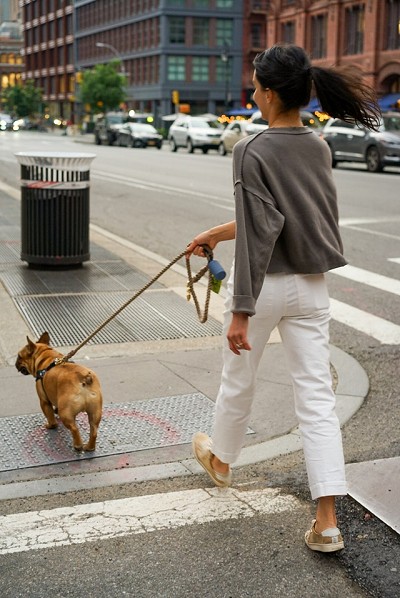
Why is pulling on the leash bad?
A dog who is pulling on the leash is focused on himself and his environment – sights, sounds, smells, other people, other dogs – that is, everything in his environment except his owner.
Often the pup doesn't even notice you at the other end of the leash. This oblivious attitude is not respectful.
So if your pup is at least 12 weeks old, we're going to give him a job to do. We're going to teach him that it's his responsibility to keep the leash loose. When his leash is on, his job is to pay attention to your whereabouts and stay close enough to you that the leash is always loose – whether you're sitting, standing, or walking around.
This simple job helps your pup become an attentive, respectful follower.
If you've had trouble taking your dog for walks in the past, I recommend that you NOT take him for any walks right now.
Instead, work with him in your house and yard until he is nearly flawless in his own familiar environment. Then you can add distractions by taking him out in public.
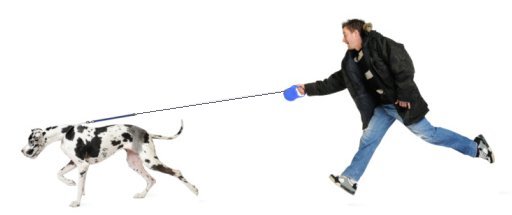
Follow these four steps to teach your pup to respect the leash and not pull
- First, learn the Loosen-Tug technique – the key to leash control
- For strong pullers, consider switching to an alternative collar
- Play the Sneak Away game – don't skip this one!
- Play the Opposite Direction game – again, very important!
Let's make sure your dog has the right collar and leash
 For most dogs, start with a flat buckle collar of nylon or leather. It simply buckles around your pup's neck. Some pups never need anything more.
For most dogs, start with a flat buckle collar of nylon or leather. It simply buckles around your pup's neck. Some pups never need anything more.
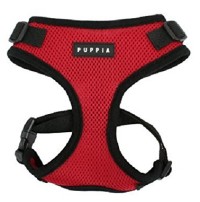 For toy breeds, you can try a lightweight collar, but some toys have a delicate windpipe and a collar makes them cough. If that happens, you can switch to a harness. I like a soft mesh harness like the Puppia® brand (pictured).
For toy breeds, you can try a lightweight collar, but some toys have a delicate windpipe and a collar makes them cough. If that happens, you can switch to a harness. I like a soft mesh harness like the Puppia® brand (pictured).
Pups who are strong pullers might need a different kind of collar. We'll find out in just a few minutes.
Leashes
I recommend a 4-foot to 6-foot leash that is 3/8" to 1/2" wide, and soft and comfortable in your hands. Most nylon leashes feel too sharp in my hand. Well-worn leather is great, but new leather is very stiff.
There will be times when you'll want a longer leash so you can move farther away from your pup, but still maintain control. A 15- to 20-foot leash or strong cord works well. Not a retractable leash, though – retractables are useless for training.
Step #1: Learn the Loosen-Tug technique
This might sound like an odd question.... but do you have a stuffed animal in your house? A plush teddy bear, for example?
Why? Because I'm going to explain some leash-handling techniques and you might want to hook your leash to a stuffed toy so you can practice before you try them with your pup. Then you'll feel more confident that you know exactly what to do.
 Go stand somewhere in your house or yard. Use the leash to maneuver your pup so he's standing close to you, no farther than a foot or so away. It doesn't matter whether he's in front of you or on either side of you, as long as he's within a foot or so.
Go stand somewhere in your house or yard. Use the leash to maneuver your pup so he's standing close to you, no farther than a foot or so away. It doesn't matter whether he's in front of you or on either side of you, as long as he's within a foot or so.
Look at the clip of the leash. Is it hanging straight down below his neck? If you're holding him with a tight leash, the clip can't be hanging straight down. So "pay out" (loosen) some of the leash until the clip is hanging under his neck and pointing down at the ground.
The section of leash that's attached to the clip should be forming a little U-shape before it starts climbing up into your hand.
That's where you want your dog to be. Everything you do now should be focused on getting your pup to stay within a foot or two of you, with the clip hanging down and the leash loose.
Don't walk anywhere. Just stand there. If your pup just stands there too, tell him quietly that he's a good boy. You want him to be calm, so use a calm voice.
If instead your pup moves away from you so the leash gets tight, you're going to do the Loosen-Tug technique:
- Reach down with one hand and grasp the leash about 12 to 18 inches from your dog's collar. Lower that hand down to the same height off the ground as the collar. Your hand doesn't need to be NEAR the collar – just the same height off the ground.
- Move that hand quickly toward your pup. That will create a tiny bit of slack in the leash. This is the loosen part of the Loosen-Tug technique.
- Then move that hand quickly away from your pup, keeping your hand parallel to the ground as you pull your pup back to within a foot or so of your leg. Either leg.
- Immediately loosen the leash so the clip is hanging down and that lovely U-shape reappears in the leash.
Don't HOLD your dog close to you. Pull him close, then immediately loosen the leash. Clip hanging straight down? Check. U-shape in the leash? Check. Again, don't HOLD your dog close to you.
 This lesson is all about repetition. Keep giving your dog the opportunity to move away from you by loosening the leash.
This lesson is all about repetition. Keep giving your dog the opportunity to move away from you by loosening the leash.
If he takes advantage of the opportunity and moves away from you, drop your hand down to his collar height, then hand-forward (create slack), hand-backward and parallel to the ground, and pull him back. Then loosen the leash again.
Remain calm. You want your pup to be calm, so keep your own movements calm. Correct him methodically. Don't say anything. Whenever he stops pulling and stands there on a loose leash, give him a single quiet "Yes. Good boy." Don't get him revved-up.

If your dog is still pulling
With persistent pups, change the gentle pull into more of a tug, which is quicker and a little more jarring.
- Drop your hand to collar height.
- Hand forward – create slack.
- Hand backward – parallel to the ground – in a fast "popping" tug that should get a determined pup's attention as it propels him closer to you.
- Loosen the leash again... and hopefully your pup will decide that pulling on the leash isn't worth that tug.
 But if he keeps pulling hard, it's time to try a different collar.
But if he keeps pulling hard, it's time to try a different collar.
Although a regular buckle collar looks mild, it exerts force on one concentrated point on your pup's throat if he's a hard puller.
That puts a lot of pressure on his throat, so you'll need to stop the pulling with a safer training tool.
Step #2: Alternative collars (if needed, and listed in no particular order)
 Martingale collar
Martingale collar
A martingale (MAR-tin-gale) collar tightens evenly around your pup's neck if he pulls. So the pressure is distributed around the neck instead of being concentrated on one point on the throat. A properly fitting martingale can only tighten to a certain point and no farther. PetSafe is a popular brand.
 British slip collar
British slip collar
This is a combination of collar and leash all in one. This collar should be kept HIGH on a strong pup's neck, right behind his ears. A good brand is Mendota.
Front-attachment harness
I don't mean a regular harness, where you clip the leash to a ring on the dog's back.
A regular harness is designed to help sled dogs pull, so if you put a regular harness on a dog who is already a puller, you're just making it easier for him to pull. Not what you want!
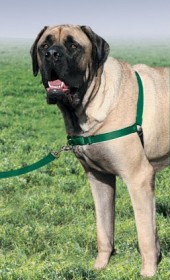 But a front-attachment harness can be effective. Here you clip the leash onto a ring on the pup's chest.
But a front-attachment harness can be effective. Here you clip the leash onto a ring on the pup's chest.
If he lunges forward and hits the end of the leash, he gets turned around in a little semi-circle until he's facing YOU instead of what he was pulling toward.
Some front-attachment harnesses I recommend include:
- Petsafe Easy Walk Harness (pictured)
- Freedom No-Pull Harness
- Kurgo Tru-Fit Smart Harness
- Sense-ation No-Pull Harness
They're each a little different in design, so you'll need to test them to see which, if any, might work with your dog.
Herm Sprenger prong collar
 If your pup is at least 6 months old and a powerful puller, you might try a HERM SPRENGER prong collar. I don't recommend or use other brands.
If your pup is at least 6 months old and a powerful puller, you might try a HERM SPRENGER prong collar. I don't recommend or use other brands.
A prong collar distributes pressure around your pup's neck evenly, so it's safer than a buckle collar, which concentrates its pressure on the front of the throat.
A prong collar can only close so far – it can't choke your pup.
If you're worried about those prongs, you needn't be. On the Herm Sprenger brand that I recommend, the prongs are rounded and blunt. They can't "stab" your pup. What they do is close together in a light "pinching" action of the loose skin on his neck...
...IF he pulls.
If he just walks beside you, there is no pressure on his neck at all. So he's the one who decides whether to pull and get pinched, or not.
A Herm Sprenger prong collar is like the power steering on your car, in which the smallest movement of the steering wheel makes the car respond. With a prong collar, you need to give only a very gentle tug (just a twitch of your wrist) and most pups respond instantly by stopping their pulling.
Cautions about alternative collars
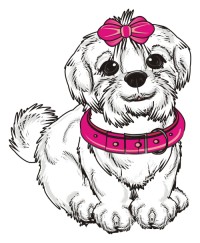 First, these are training tools. Don't leave them on your pup when no one is watching him. He could get them caught on something.
First, these are training tools. Don't leave them on your pup when no one is watching him. He could get them caught on something.
Second, these tools should be used on a temporary basis, to get across to the dog that you want him to stand and walk quietly on a loose leash.
If your pup is ONLY controllable when he's wearing a specialty training tool, he's respecting the tool – not you.
That's okay at first, but your goal is to establish the right leader-follower relationship in which your pup stays beside you simply because of YOU.
A trusting follower dog has so much respect for you, so much faith in you as a leader, that he wants to stay close to you.
Step #3: Play the Sneak-Away game
Once your pup will stand beside you on a loose leash, once he clearly understands that he mustn't pull when you're standing still.... it's time for you to move.
Take three steps. Then stop. Where is your dog?
- Did he follow you so that the leash is still loose? "Yes! Good!"
- Or did he move away so the leash is now tight? Use the Loosen-Tug technique – hand forward to create slack, hand backward to move him a foot or so in your direction, so the leash becomes loose again.
Remember, don't hold him on a tight leash. It's HIS job to keep the leash loose by paying attention to your whereabouts and following you. When he isn't doing his job, your job is to remind him to do it.
Take another three (or more) steps and stop. Your steps can be forward, to the left, to the right, even backwards. Make it a game in which you try to sneak away from your pup when he isn't paying attention. Don't forget the praise if he is being attentive!
Most pups end up loving this game and act quite pleased with themselves when you can no longer sneak away from them!
When your pup becomes good enough at this game that no matter what direction you go in, he follows you and the leash always remains loose, it's time to....
Step #4: Play the Opposite-Direction game
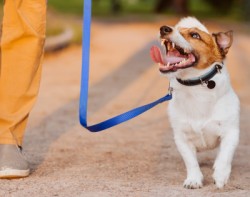 Maneuver your dog onto your left or right side. He should be within about 12 inches of your leg, with his head roughly even with your leg (a little bit behind or ahead of your leg is fine).
Maneuver your dog onto your left or right side. He should be within about 12 inches of your leg, with his head roughly even with your leg (a little bit behind or ahead of your leg is fine).
Whichever side your pup is on, hold the leash in that hand. Drop that arm so it's hanging down beside you, the way you would normally walk by yourself, without a dog.
Is the clip of the leash hanging straight down? Is there a nice U-shape where the leash comes off the clip and starts climbing up into your hand? That's the lovely loose leash we're looking for!
When he's walking nicely, praise him and give an occasional tiny treat if you like – but don't stop walking!
Whenever the leash doesn't look like that, or whenever your pup gets half of his body ahead of your leg or too far off to the side, it's your job to bring him back into position.
Along with the Loosen-Tug technique, there's a little game called Opposite-Direction that will quickly get your pup sticking more closely to your leg.
Here's the game – when he forges ahead, turn and walk briskly in the opposite direction. You can reverse direction by turning away from your dog, or by turning toward your dog.
I'll explain how to do it both ways.
Reverse direction by turning AWAY from your dog.
- Suppose he's walking on your left side. Make a 180-degree turn to your right. For you military marchers out there, that's a "right about-turn."
Keep walking the whole time. Now your pup will find himself behind you and will need to hurry to catch up.
 If he catches up but charges past you, reverse yourself again. Again he will find himself trailing behind and will need to scramble to catch up.
If he catches up but charges past you, reverse yourself again. Again he will find himself trailing behind and will need to scramble to catch up.
It won't be long before he realizes that for some bizarre reason, whenever he forges ahead, it causes you to walk in the opposite direction.
- You should start to see him be reluctant to move ahead of you, lest he cause one of your cuckoo direction changes!
Good! Your pup should not be way out in front of you where he can't even see you. He should walk beside you, using his eyeballs to keep tabs on your whereabouts. It's the respectful thing to do.
Reverse direction by turning TOWARD your dog.
This turn, where you make a 180-degree turn to your left, is a little more complicated because the pup is in your way. You don't want to trip over him.
The solution is to turn left toward your pup before he has gotten ahead of your leg. You can even use the leash to hold him back behind you a bit as you begin to make the turn.
Assuming he's on your left side, pivot on your left foot and AS you make the turn, swing your right leg/foot in an exaggerated motion across your body and in front of your pup's head. Your swinging leg/foot will remind him to hang back as you complete the 180-degree turn and walk in the opposite direction.
If you make frequent about-turns (to the right and to the left), pulling can be stopped quickly. If it isn't working for your dog, re-visit the earlier section on alternative collars.
My best-selling books – now available FREE on my website
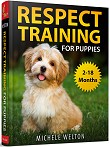 Respect Training For Puppies: 30 seconds to a calm, polite, well-behaved puppy is for puppies 2 to 18 months old. Your puppy will learn the 21 skills that all family dogs need to know. Click here to read for free.
Respect Training For Puppies: 30 seconds to a calm, polite, well-behaved puppy is for puppies 2 to 18 months old. Your puppy will learn the 21 skills that all family dogs need to know. Click here to read for free.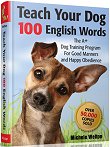 Teach Your Dog 100 English Words is a unique Vocabulary and Respect Training Program that will teach your adult dog to listen to you and do what you say. Click here to read for free.
Teach Your Dog 100 English Words is a unique Vocabulary and Respect Training Program that will teach your adult dog to listen to you and do what you say. Click here to read for free.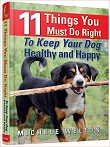 11 Things You Must Do Right To Keep Your Dog Healthy and Happy helps your dog live a longer, healthier life. Get my honest advice about all 11 Things before you bring home your new puppy, because some mistakes with early health care cannot be undone. Click here to read for free.
11 Things You Must Do Right To Keep Your Dog Healthy and Happy helps your dog live a longer, healthier life. Get my honest advice about all 11 Things before you bring home your new puppy, because some mistakes with early health care cannot be undone. Click here to read for free.
